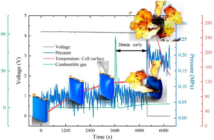A Capacitor is one of the most basic components of almost all electric circuits. A capacitor can store electric charge like a fully charged battery but, unlike batteries, it cannot produce electrons. It just stores the charge and releases it in an instant.
Structure of a Capacitor
A capacitor consists of two flat conducting plates usually made of a metal, like silver or aluminum. The two metal plates are closely placed parallel to each other and separated by a thin insulating material. This insulating material is called Dielectric and is generally made up of Mylar, glass or ceramic. The two metal plates are each connected to a wire which is connected to the rest of the circuit.
Symbolic Representation of a Capacitor
The capacitor is symbolically represented in a schematic diagram of a circuit in two ways: two parallel lines separated by a gap (Fig. 1) or a combination of a straight line and a curved line (Fig. 2).

The curved line is generally used on the negative side of the circuit. Most of the capacitors are polarized, i.e. they have distinct positive and negative terminals. Connecting voltage in the wrong direction can damage the capacitor.
How does a Capacitor Work?
When the capacitor is connected to a power source, such as a battery, the negative terminal of the battery begins pushing the electrons towards one of the plates. Simultaneously, the positive side of the battery starts attracting the electrons from the other plate. This flow of electric current results in the development of an electric field between the two plates, and so voltage is created. The voltage between the two plates increases as the difference in charge between the two plates increases. This build up continues until the capacitor voltage equals the battery voltage. Once their voltages are the same, current stops flowing through the circuit, and the capacitor is said to be charged. Once a capacitor has been charged, you can disconnect the battery from the capacitor, and the voltage will remain stored in the capacitor.
Unit of Measurement of a Capacitor
Ability of the capacitor to store charge after being disconnected from a power source is called Capacitance. Capacitance may be defined as the amount of electric charge that is stored in the capacitor at a voltage of 1 Volt. The unit of measuring capacitance is Farad (F), named after Faraday.
Applications of Capacitor
A capacitor in an electric circuit can be used for local energy storage, voltage spike suppression, and complex signal filtering. The capacitor is also used to break the current in direct current (DC) circuits. As soon as the charge on capacitor equals the charge on the battery, the current stops flowing through the capacitor and it thus breaks the continuous flow of current in DC circuit. In alternating current (AC) circuits, capacitor discharges to the circuit when there is a large voltage drop and thus boosts the voltage up to hold the circuit..
Related Posts:



